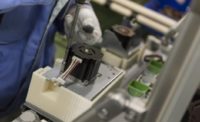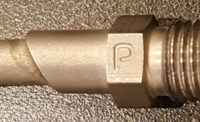
By controlling when the elements are fired with delay laws, the effective depth and angle of the beam can be controlled. Options include scanning over a range of angles, a range of depths, focusing parameters and display characteristics as shown here. Source: Image created from CIVA example provided by Mark Dennis at EPRI
Historically, radiographic testing (RT) has been the nondestructive testing (NDT) method of choice for inspection of critical welds in a variety of applications. By providing a pictorial, volumetric record of areas of interest, it was, and for some purposes still is, the best choice for many applications.
While it gives expected results, RT has significant drawbacks, which in many cases make it prohibitive to use from a safety and cost perspective. Use of industrial radiography in the field requires complete shut-down and evacuation of large areas around the inspected part for extended periods of time regardless of whether gamma or X-ray energy sources are used. The inspection team usually requires an additional four, and sometimes as many as 30, personnel to ensure safety. This complete work stoppage is a financial drain from both the standpoint of work time lost and the funding of additional personnel.
Additionally, the United States has increased security requirements for handling, storing and using gamma isotopes, resulting in facilities performing RT inspections looking for alternatives.

The pipe with weld and counter bore is shown in 2-D and 3-D. The probe is shown in 3-D with the delay laws displayed in red. A representation of a sectorial scan from 30 to 70 degrees in steps of 1 degree is shown. Using this graphical representation, it is easy to see if the placement of the probe will support a scan of the area of interest. In this example, if the backwall is the only area of interest then the probe placement is shown to be sufficient. If, however, the intent is to inspect the entire weld and heat-affected zone, then a combination of scans and probe movement is clearly needed. Source: Images created from CIVA example provided by Mark Dennis at EPRI
Another Inspection Method
Due to the inherent dangers and cost associated with RT, the industry has been developing improvements to the “second best” inspection method-ultrasonic testing (UT). Traditionally with this method, a small component, called a transducer or probe, contains either a single or dual element that sends and receives sound through a part. By monitoring any disruption, or loss of sound in a component, the inspector can theoretically locate defects anywhere in the part. A single inspector can work fairly quickly while not causing danger to others working in the immediate vicinity. Using the correct element and equipment settings, this method provides adequate results at a fraction of the cost and with minimal disruption of work.Given the advantages of UT, why is it not always the first choice when inspecting critical parts? The simplest answer is that RT provides a permanent picture-either film or digital-of the inspection that can be reviewed, audited and stored for years.
UT, on the other hand, relies heavily on the experience of the individual inspector. Poor or inexperienced transducer manipulation, non-optimal equipment parameter settings and administrative acumen of the inspector can all affect whether an area is inspected properly. The correctness of the report depends on the accuracy in which the transcribed records were completed by the UT inspector. In order to overcome this drawback, manufacturers are constantly developing computer-aided equipment that provides real-time recording of inspection parameters and acquired data while not relying on personnel experience or accuracy. During the past several years, another significant technological improvement has been the development of phased array ultrasonic test (PAUT), which provides a volumetric inspection while ensuring extreme accuracy, speed and safety.

Two different defect shapes and three different defect orientations are shown. The position of all four defects in the part is the same. Source: Magsoft Corp.
Phased Array Ultrasonic Test
Unlike conventional UT, PAUT can inspect several different angles and depths within a part using only one transducer. The ability to perform a volumetric sectorial scan electronically with a PAUT transducer greatly increases the likelihood of detecting critical flaws such as cracks and lack of fusion as compared to conventional UT.While PAUT systems offer many advantages over conventional UT, these systems also are significantly more complicated to understand and use. As with standard single element probes, a phased array probe can be placed on a wedge so that it steers the ultrasonic beam at a specific angle. The difference between a standard single element probe and a phased array probe is that the phased array probe contains several separate elements in a row that can be fired at different times. By controlling when the elements are fired with delay laws, the effective depth and angle of the beam can be controlled. Options include scanning over a range of angles, a range of depths, focusing parameters and display characteristics.
Because PAUT probes are significantly more complex than standard single element transducers, PAUT probes also cost substantially more. In the past, choosing the right probe for the job may have been accomplished by purchasing several different probes, then experimentally determining which gave the desired outcome. Due to the cost and complexity involved with PAUT probes, experimentation to find the optimum result quickly becomes prohibitive. The single greatest process improvement arises from the development and use of simulation software, which quickly and accurately allows the operator to virtually determine the optimum probe to purchase and which inspection parameters are needed for any given application.
Software Solutions
With some simulation software, it is possible to model a large variety of PAUT probes, including linear arrays, matrix arrays, annular arrays and both 2-D and 3-D flexible arrays. The physical mockup that would ordinarily be used experimentally is replaced with a simulated part. The operator can either choose from a library of pre-existing shapes, or import a 2-D CAD image that can be extrapolated in a cylindrical or planar direction. To model a pipe weld, a 2-D image could be generated. Using interface surfaces, it is possible to define the weld as a separate material from the base material. For example, the base material can be isotropic steel, while the weld is anisotropic steel.As facilities look to replace RT of critical welds with PAUT, they also look for ways to ensure that they are not reducing the effectiveness of their inspections. In the age of “working smarter, not harder,” simulation software is a useful and cost-saving technology. Simulation software facilitates the migration from conceptual proof of process to production applications, while optimizing results with minimal, nonvalue-added effort, and no unjustified equipment purchases. RT will continue to be replaced with PAUT in many industrial applications because PAUT is the only alternative currently available that can maintain the quality and integrity of the inspection results while lowering costs and increasing safety. Partnering a phased array ultrasonic system with simulation software provides state-of-the-art solutions for today’s critical component inspection applications. NDT


